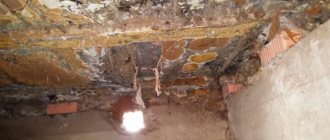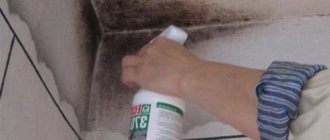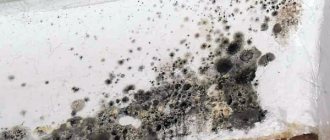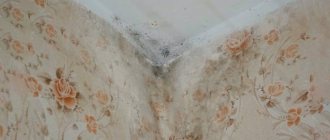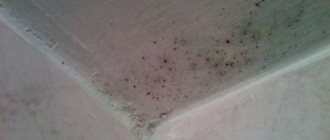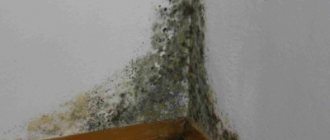Black mold and mildew appear in dark, damp conditions and lack of fresh air. Therefore, it is not surprising that dark spore plaque, as well as white mucus, cover the walls of cellars, basements and even the foundation. Today we’ll look at how to get rid of mold in the basement and fungus in the underground.
Remedies for basement mold
Basements and cellars are buried in the top layer of the earth, so dampness will be felt here constantly. This is due not only to the lack of sunlight, but also to underground water that can seep inside, as well as temperature changes that provoke the formation of condensation.
If there is poor ventilation, an unpleasant musty smell of mold will very quickly appear, which you will have to fight.
Traces of mold, fungal spores and foul odor should be removed at the first suspicion of their presence. Letting the situation take its course means facilitating the rapid proliferation of harmful microorganisms that infect everything around, causing damage not only to property, but also to human health.
There are many means to cope with the problem. Some of them are produced by the chemical industry and can easily be found on the shelves of hardware stores. Others may be at hand, and are included in recipes known to great-grandmothers - these are everyone’s favorite folk remedies.
Home remedies are only appropriate for minor areas of mold damage . When the fungus penetrates deep into the structure of the material, folk remedies are powerless. What to do in this case is to take more radical measures. It is possible to even call specialists of the appropriate profile to take care of the sanitation of the basement or foundation.
When working with products, do not forget about their harmful qualities. Therefore, you should first of all protect yourself by wearing a protective suit, gloves, a respirator, and sometimes safety glasses. You need to be wary of chemical burns on your body and inhalation of harmful fumes.
Copper sulfate and lime
The most affordable means is whitewashing surfaces with slaked lime. But if you enhance the effect of the chalk composition by adding copper sulfate, you can get rid of mold in the underground more effectively. Each product is diluted separately in a small amount of water. In this case, take 100 g of vitriol and 1 kg of lime.
It must be remembered that the lime solution is poured in a thin stream into the vitriol solution, and not vice versa.
Lemon acid
Citric acid can be called an ideal tool for removing fungus and the smell of rot when it comes to small lesions. In this case, the composition should be quite concentrated - 100 g of powder per 1 liter of water.
It is not rational to use citric acid over large areas due to the high cost of the resulting composition.
Chlorine and Whitening against mold
Disinfectants include preparations containing chlorine (the well-known one is “Whiteness”, which is used everywhere even in the food industry). You will need a fairly concentrated solution to remove the fungus in the basement.
Treating mold with white is simple:
- Pour several bottles of bleach into a bucket.
- If necessary, dilute with water according to the instructions.
- Using a broom, brush or spray bottle, generously moisten the affected surface with white.
- Dry the room.
Chlorine vapors are harmful to the nasopharynx and eyes, so precautions should be taken. At a minimum, a carbon respirator and goggles. A complete set is desirable - overalls and gas mask. There must be forced ventilation at the time of processing.
Combustible sulfur bombs
You can get rid of fungus in the basement with a smoke screen of sulfur (using a flammable bomb). It is enough to place the checker in a metal container with a stable bottom and set it on fire. first close all ventilation openings in the underground . After a few hours, the mold and smell of rot will disappear for a long time. The flammable substance itself quickly evaporates.
During the disinfection procedure (or better yet, for a couple of days), people and animals will have to leave the house.
Torch or blowtorch
Some try to fight fungal spores with fire using burners. At the moment, the product gives an effect, but does not eliminate the appearance of new rot , since it is not a disinfectant.
Hydrochloric acid
Hydrochloric acid will help get rid of mold for a long time (it can completely destroy spores) if you thoroughly treat all surfaces with it. The solution is made weakly concentrated (instructions to help), and it is used to treat not only the walls, floor and ceiling, but also shelves, racks, and containers. In this case, all food in the cellar should be removed .
Hydrochloric acid, even in low concentrations, can cause burns. Therefore, you will need fairly dense protection for all parts of the body.
The list of folk remedies can be endless, but all of them are short-term if the root cause of the formation of fungi and mold is not eliminated!
What is mold?
People hardly think about this until they discover that their home has been colonized. Fungus in the basement of a private house is a good reason for starting “military action.” Mold is spores, they are invisible, but they are present in the air almost everywhere. If they find ideal conditions for life, they quickly settle in, then begin to actively reproduce, so soon the owners discover their appearance.
Types of molds
To become familiar with a living threat and then be able to get rid of it, you first need to know what types of it exist.
Blue
This “cute” type of fungus does not often “visit” living spaces. Her “home” is growing trees. The first sign is a bluish-bluish coating on the wood. This mold is practically harmless to humans. The main proof of the absence of a threat is the production of elite cheeses, in which “blue” spores take an active part.
White
White mold, or, scientifically, mucor. If we can talk about the existence of “relatively good” fungi, then this applies specifically to their white variety. This mold often settles in the soil, on baked goods, and on cheeses. For humans, mucor is not too dangerous, however, with a long “neighborhood”, white fungi can still cause damage to various internal organs.
Green
This type of mold also has a name - ascomycetes. Their usual habitats are compost, soil, various organic materials and food products - fermented milk, fruits, vegetables. However, green mold does not “disdain” stones; on them it “disguises” itself as moss. The danger of the species is its deep penetration: you can become poisoned by food even if you remove the entire contaminated layer.
Pink
This fungus differs from its colleagues in that it does not “eat” into surfaces: the mycelium of pink mold is not able to attach itself to ceilings or walls. More often it settles on products whose storage conditions are not ideal. These include grains, cereals, fruits, and vegetables. However, mold can move from them to hard surfaces. The fungus does not pose a danger to humans, but it is not recommended to eat such food.
Gray
This species - saprophytes - poses a direct and obvious threat. Its spores attack absolutely all surfaces (including plant seeds, food), penetrate them and grow quickly. The first sign is a not very noticeable gray coating. The main reason for formation is humidity. Gray mold, unlike other varieties, is very difficult to remove due to the deeply rooted mycelium.
Black
If a fungus is found in the basement of a private house, then most often we are talking about this “aggressor”. This species is known for preferring to settle and breed in residential areas. It has several subspecies. Some of them are safe, but they grow instantly, so you need to start fighting them immediately after detection.
Other strains can cause allergic reactions, respiratory diseases, gastrointestinal pathologies, and digestive system disorders. Since the owners will not be able to understand the types (dangerous/safe), any of the strains of black mold must be immediately exterminated.
Basement housing is ideal
Mold can live and reproduce on any surface: on food, on concrete, wood and other materials. The main conditions for its “prosperity” are dampness, relative warmth (18-20°) and darkness, which is why basements often become the habitat of mold. Why? There are several favorable factors.
- Optimal indoor temperature in summer. Even in the heat, it is rarely very high in the basement, so due to the temperature difference between outside and inside, condensation forms on the walls and ceiling. High humidity is the first ideal condition for the growth of fungus, so its appearance is only a matter of time.
- Poorly made ventilation. If there is at least a natural inflow and the same exhaust, then the air in the basement stagnates, mustiness and dampness appear. It is humid, still air that is the optimal environment for the rapid growth of mold.
- Lack of waterproofing and thermal insulation in the basement. These are the main reasons for the formation of condensation.
- Insufficient lighting or lack thereof.
Wooden objects (for example, shelves), various products and workpieces also contribute to the active growth of mold. Therefore, fungus in the basement of a private house is not an exception, but a very common phenomenon.
Why is fungus dangerous?
If measures are not taken in time, the building will be in danger, since a large (and constantly increasing) colony of spores can gradually destroy even the most durable building and finishing materials. But it becomes a serious threat not only to the basement and the entire house, but also to the people living in it.
As mold grows, it regularly releases new batches of spores into the air. The larger the colony, the more dangerous it becomes even for a short time to stay in an infected room. The spores contain toxins that cause pathology. The most common consequences of contact with mold include:
- allergy;
- bronchitis, bronchial asthma;
- sinusitis;
- dermatitis;
- conjunctivitis;
- laryngitis, pharyngitis;
- thrush;
- pneumonia;
- stomatitis;
- tracheitis;
- eczema.
Diseases of the musculoskeletal system can be added to the same list. Frequent headaches, dizziness, causeless irritability, constant “colds”, upset stomach or nausea are symptoms warning of an undesirable neighborhood.
The consequence of these manifestations is exhaustion, and this condition is a direct path to serious illness. The most susceptible to any pathology are young children and the elderly, as well as those who, due to past or chronic diseases, have severely weakened immunity.
How to get rid of mold in the basement and underground of a private house
It is not enough to choose one of the means to remove rot in the basement and cellar - you also need to properly prepare the room for disinfection, as well as pay attention to waterproofing and establish a ventilation system.
Cleaning (room preparation)
Before processing the basement, it must be prepared.
- All food and items stored in the basement are removed . The shelves are removed and taken outside along with the racks. The same is done with containers. If the floor of the room is covered with boards, they should also be removed.
- All wooden elements must be thoroughly dried outside under the sun. Therefore, it makes more sense to carry out disinfection in the summer, when it is a dry, windless day. After this, you need to treat the wooden surfaces with disinfectants in 2-3 layers. If the material is significantly susceptible to damage, it is better to get rid of shelves and racks, replacing them with new, pre-disinfected ones.
- Metal structures and containers are washed, cleaned of rust and disinfected. Then they should be painted using a pre-bactericidal primer.
- Concrete and brick walls of the cellar are thoroughly cleaned with a wire brush . All rot stains must be removed. If the walls are plastered, it is recommended to knock down the layer of plaster riddled with spores.
- In the version with an earthen floor, it is necessary to remove the top layer of soil in which spore fungi can live.
Having finished with the preparation, begin to disinfect all surfaces using a whitewash brush. In versions with copper sulfate, slaked lime and chlorine-containing preparations, it is convenient to distribute the solution over surfaces using a spray bottle. For clarity, you can watch the video.
Waterproofing, treatment and wall covering
The main reason for the development of mold is considered to be dampness, so you should worry about waterproofing the walls of the basement. Before starting work, the basement should be thoroughly dried. To do this, you can use electric fireplaces or an industrial hair dryer.
- After inspecting the walls, remove crumbling surfaces and open up existing cracks, which should then be sealed.
- You can coat it with special solutions such as Penetron or Aquastop; these products can stop water from penetrating into the basement.
- Depending on the depth of the defect, a sand concrete solution or plaster for wet rooms is used.
- For reliability, you can apply an additional layer of cement putty.
- After allowing the composition to dry, treat the walls and ceiling with an antifungal agent.
A good insulation solution is a second wall, which should be 3-5 cm away from the main wall to eliminate the risk of condensation. A moisture-resistant material is used as a false wall, in which several holes must be made for ventilation.
It is advisable to fill the floor with a concrete screed and ensure that no gaps form in it. Waterproofing of the floor will be provided by a drainage layer, for which it is best to use expanded clay.
If water constantly penetrates into the basement, only external waterproofing will help; the problem cannot be solved from the inside.
Ventilation against dampness
The cellar ventilation system is installed during the construction of the house; in theory, it should completely remove dampness from the basement. If it does not cope with its function, then it should be improved a little . You can remove 2 additional pipes from the room - one at floor level, the other under the ceiling.
Another option is holes in the door leading to the basement, or cracks around its perimeter. All this will ensure air movement, bringing a fresh flow inside. You can also install forced exhaust.
How to fill the underground from dampness
Builders do not have a clear opinion regarding filling the underground space.
Some believe that in this way you can make the house much warmer, others, on the contrary, believe that this will lead (especially with high groundwater) to rotting of wooden boards and floor elements. Because moisture from the soil will seep out more intensely and settle as condensation on the tree.
In our opinion, materials such as slag and expanded clay are much more suitable than clay.
How to remove dampness in the basement and underground of a private house:
- To prevent the filler from getting wet on the ground, waterproofing (roofing material, rubemast, glass insulation, or, in extreme cases, dense reinforced greenhouse film) is laid to cut off groundwater.
- The edges of the waterproofing are turned up vertically so that it is between the filling material and the foundation base.
If you decide to fill with clay, then this should be done according to the rules that are used when constructing a clay castle. To put it briefly, they take fatty clay, leave it in a heap next to the house for the winter, then use it by laying crumpled clay under the house in the underground space and compacting it.
This minimizes the moisture conductivity of the clay compared to ordinary clay.
Mold detected: what to do?
In order not to run into problems with the building and to protect loved ones, when a colony is first discovered, it is better to immediately seek help from professionals. If the fungus in the basement of a private house was noticed on time - at an early stage, then you can try to eliminate the threat yourself. But first we need to determine the damage caused, the scale of the “disaster”, and therefore the scope of work.
Possible methods
There are several effective ways. One of them is a major repair, which makes sense to start if the degree of damage to the surfaces is very serious. When mold has “conquered” only a small area, you can limit yourself to its local elimination and preventive methods in the future.
For example, many owners prepare a solution based on formalin (40%): 250 ml is diluted in 10 liters of water. After treating the affected area, it is dried, then plastered again, then the ceiling or walls are whitewashed (painted). If the ventilation is done well, the fungus most often recedes.
If large areas of the basement are affected by mold, then a whole range of measures is necessary. It includes:
- intensive heating of the basement with warm (hot) air;
- the use of strong drugs: purchased or made independently;
- repair: replacement of damaged building materials (for example, wood panels).
Another important condition for defeating mold is the creation of efficient ventilation. It can be traditional vents - vents arranged in opposite corners. The lower part of the inflow pipe is located closer to the floor, the bottom of the exhaust pipe is located under the ceiling. Both channels lead to the roof of a separate building, or through the walls if the basement/cellar is located under the house.
Where to start a “war” with the aggressor?
For the fight to be successful, you must follow a specific plan of action. It includes several points. First, the reason why the basement has become a breeding ground for mold is determined.
Preparation
More often than not, high humidity is to blame, so the first step is to eliminate its source. Then they move on to studying the colony. In this case, the most important thing is to determine how deeply the fungus has penetrated into the material of the walls and ceilings. Sometimes removing decorative coatings and plaster gives a positive result.
However, it often happens that the hosts’ holiday does not last long. Mold in this area appears again after some time. Therefore, it is better to immediately take the problem seriously: fungus in the basement of a private house requires drastic measures. First of all, use a method consisting of several stages. The first of these is the removal of food and all items from the premises. These include containers, shelves, racks. If the floor is made of boards, then it is also dismantled.
All wooden structures are dried in the sun, damaged furniture elements are replaced with new ones, then the surfaces are treated with antiseptics. Better - 2-3 layers. Metal products are washed, cleaned of rust, and disinfected. Then they are treated with an antiseptic primer, and after it dries, the products are painted.
How to protect the basement?
Then they begin further actions, but already inside the basement.
- First, the decorative coating is removed, then they move on to plaster. All areas of material affected by mold are cleaned with a spatula (wire brush). Places where the material has become loose due to moisture are treated especially carefully.
- Then dilute a special/homemade anti-mold agent and spray not only the affected areas, but also all surfaces. The reason for this precaution is logical: in the air of the room where the colony has settled and expanded, the concentration of spores is increased.
- After the surfaces have dried, an antiseptic composition is applied to them - a deep penetration primer (Universal, ArmMix Universal), preferably also in 2-3 layers. Then the walls are treated with waterproofing material.
- The primer is applied again, after it has dried, the surfaces are plastered and puttied. The penultimate stage is primer treatment. The last operation is painting the walls and ceiling (whitewashing).
If the basement floor is earthen, then remove the top layer, because spores can also live in it. Then the surface is treated with copper sulfate. Only such thorough cleansing will make it possible to get rid of the fungus forever. Otherwise the problem will soon return.
What to do with the foundation if groundwater passes nearby
Often the reason for the development of rot is groundwater penetrating into the underground, which is located quite close to the surface of the earth. This factor can be eliminated by a number of actions. If a drainage system was not provided outside, then there will be water on the floor in the basement .
The groundwater level under the foundation of a house can be artificially lowered by installing a drainage system outside. It should be buried below the expected groundwater level, while providing layering . This will prevent moisture from penetrating into the underground and will keep the ground around the house dry. Then fungus is unlikely to appear on the foundation.
How to get rid of fungus in the underground of a wooden house
The smaller the basement, the more difficult it is to ensure normal air circulation in it. Therefore, special attention is paid to openings in underground walls . They must be end-to-end with access to the street and located opposite each other at a height of at least 40 cm from ground level. The optimal ones are squares with sides of 15-20 cm, covered with mesh (to prevent the penetration of rodents and debris).
Treating a small room with disinfectants containing harmful fumes is dangerous for humans . Therefore, in order to get rid of mold in the basement of a wooden house, it is better to use slightly different methods of combating mold, determining how to eliminate the problem.
- The same smoke bombs as described above will do.
- You can use hydrochloric acid, but in a different way - pour it over table salt. In this case, the container should be glass or ceramic, and it should be placed on the floor in the center of the room.
- White moss powder absorbs harmful spores well. It is poured into metal containers and placed in the corners of the basement.
In a wooden house, using an electric fireplace to dry the underground room is risky due to the possibility of fire. The option of a professional hairdryer in a small basement is also out of the question. Here you can apply popular recommendations - lay out heated ceramic bricks in the underground on the ground along the walls . They absorb moisture well and can be heated several times.
If possible, whitewashing the inside of the walls can help. You can also mix lime with underground soil.
How to get rid of mold on boards and joists
If the damage is not significant, watch the video instructions on YouTube. In case of serious areas of rot, it is recommended to cut out the boards with joists and replace them with new ones treated with bioprotection.
Why does mold appear in the underground?
The underground floor is separated from the living space only by a wooden floor. Therefore, the temperature difference in the house, outside and in the underground, especially in winter, is very noticeable: in the rooms it is warm, in the underground it is cold.
Due to temperature differences, condensation forms in the underground room, increasing the humidity level. Add to this the stagnation of air (homeowners rarely think about underground ventilation) - and it turns out to be an ideal place for mold to appear.
In addition, the fungus develops under the following “additional” conditions:
- lack of insulation and waterproofing (walls and floors of the underground, as well as floors of the first floor);
- lack of anti-corrosion coatings on subfloor surfaces;
- use of wooden materials.
All of these factors are common for any subfloor. When they are combined, it is very difficult to overcome mold: even if it can be eliminated for a while, under such conditions it will still appear again.
Where does it appear most often?
Most often, fungus occurs in the corners of walls bordering the street, as well as on cracks in surfaces. It is in these places that the most moisture accumulates, and it is here that it is most convenient for spores to “catch on.” Mold can also be found on other areas of walls, floors and ceilings where liquid accumulates or condensation forms. Also, the fungus spreads over time from the point of initial appearance.
Moldy floor boards
The favorite places for mold to grow are wooden subfloor elements, since wood absorbs moisture very well. Mold may appear under floorboards, on wooden joists (on which the boards lie). Here it appears more often due to temperature changes: in the rooms on the first floor it is warm, but under the floor it is cold and damp, which is why moisture condenses on the lower sides of the boards.
Why is fungus dangerous underground?
Fungus in the underground is a common phenomenon: you can probably find it in every second house (if it has an underground). There is much more harm from it than it might seem at first glance:
- Mold accelerates the destruction of all structures under floors, especially in wooden houses (or on wooden structural elements: on boards, beams, finishing materials).
- Originating on the ground and on boards, the fungus quickly spreads to the ceiling, and from there it penetrates into the living spaces of the first floor. Then he can move to other rooms.
Remember : mold spores harm not only the building, but also human health. Moreover, they can get into the air, even if the fungus has not yet reached the rooms on the first floor.
How can you tell if there is mold in your crawl space?
If your crawl space or basement is damp, expect mold to appear. The sooner it is noticed, the easier and faster it will be possible to destroy it.
For “diagnosis”, it is recommended to periodically look into the underground. When going down here, always inspect corners and places where condensation has accumulated. It is in these places that the mushroom appears first.
Mold becomes visible much later than it appears. First, small colonies grow into surfaces. Even before they become visible to the naked eye, they begin to absorb oxygen and produce their own enzymes, which have an unpleasant musty damp smell. Therefore, if a persistent smell and feeling of dampness appears in the underground or in the rooms on the first floor, mold is probably already beginning to grow.
How to Get Rid of Mold in a Garage Basement
Some car owners make their garage multifunctional by arranging basements there to store food supplies for the winter (especially those who live in apartment buildings do this). Typically, such cellars are an addition to the inspection hole and do not take up much space. Therefore, a slightly different method is required to remove fungus and mold.
Treatment of the garage against mold in the basement is carried out by all available means described above, BUT:
- The use of hydrochloric acid will have to be avoided , since its vapors can damage the metal parts of the machine and tools.
- It is also risky to use chlorine-containing products in small rooms without ventilation.
- Burners and smoke bombs are excluded due to the proximity of fuels and lubricants and rags.
An effective option to get rid of mold in a garage basement is lime whitewash. It is also recommended to spread slaked lime on the shelves and floor of the cellar - it absorbs moisture well and neutralizes fungal spores.
Mold and mildew in the basement of an apartment building
Problems with mold in the basement of a private house are resolved by the owners themselves. But what should residents of apartment buildings do, how can they get rid of fungus? It will be difficult for residents to cope with the problem on their own - the areas are too vast. In addition, utility services that receive rent are responsible for the technical condition of the house .
They are required to regularly inspect the technical premises located under the house and assess their condition. If fungi are detected, appropriate measures must be taken with the involvement of sanitary sanitation services.
If this does not happen, and the mold continues to develop, residents can collect a collective statement to take action and submit it to the head of the management company (MC), sending a copy to the housing inspectorate . If you do not respond, you can file a complaint in other places:
- To the management company itself
- To the district/city administration (The most ineffective government agency)
- To the State Housing Inspectorate (the most effective government agency after the court)
- To the District Prosecutor's Office
- To the Court (Long, nervous, and also difficult without a lawyer)
- To another management company (If nothing helps, is there any point in continuing to remain in the same management company? You can try to change it).
Where should you not complain?
- To the police. They will refuse to initiate a criminal case with a note stating that you have a civil dispute.
- There is no need to write a complaint to the regional prosecutor's office until you have written to the district prosecutor's office. The complaint will be sent down, and you will only waste your time. Contact the top only if the bottom does not help.
- To the administration of the president, governor, etc. The same situation as in the previous case. Go only if the district administration, the prosecutor's office and the State Property Committee did not help.
- Deputies. They simply forward the complaint to the appropriate authority. They are not capable of anything else.
- Senior at home. This is a person who doesn't decide anything.
Does mold often appear on the foundation of your home? This is either fungus from the basement starting to penetrate outside, or the drainage system around the house is broken. If a private owner can still cope with a similar situation himself, using recommendations regarding mold in the basement of a private household (described above), then the apartment building is under the jurisdiction of the housing and communal services, which should worry about disinfecting the foundation.
In a situation where mold has appeared on the foundation, special services are involved that have the appropriate equipment to dry the foundation and treat it. They also use stronger antiseptics.
What is mold afraid of?
It is easier to remove mold and mildew when measures are taken to prevent their occurrence. Therefore, prevention for rooms with high humidity should be mandatory so as not to guess why rot appeared.
What mold is afraid of:
- The specific nature of basements contributes to the appearance of humidity there. Therefore, it should be monitored regularly. You can prevent the appearance of moisture with the slaked lime already described above, which is recommended to be poured on the floor or kept in open containers on shelves.
- Lime mixed with sand should be poured into the boxes where food preparations are stored.
- During cold and wet seasons, you can periodically burn sulfur , the vapors of which will prevent rot from developing.
- Ventilation is of great importance. Don't rely on the ventilation system alone. It is recommended to leave the doors to the basement open for several hours from time to time .
- The white moss powder mentioned above can be used for preventive purposes by placing small jars on the shelves. In this case, it is necessary to change it periodically.
Don't wait for mold to appear in the basement. Treatment of walls, ceilings, floors, as well as racks, shelves, and drawers should be carried out every summer, preparing the room for storing new products.
Destruction of fungal formations
If the cellar is covered with mold, you should immediately begin to fight it. This is painstaking work that will require significant effort. Before treating the basement, it is necessary to destroy the causes of the fungus. In this case, it is necessary to use comprehensive measures of influence. This will not only remove harmful formations, but also prevent their reappearance. Next, we will look at how to remove mold in the cellar.
Preparatory work
At the initial stage, it is necessary to prepare the premises for processing. Food and other items that may interfere with disinfection are removed from the cellar. If the basement has high-quality waterproofing and exhaust hood, the humidity level in it should not exceed certain values. The surface of the walls, ceiling and floor is carefully inspected. They should not have cracks through which water can seep in and soil can spill out. If present, defects should be repaired using patches or cementation.
Drying the basement:
- An open container with slaked lime is installed in the center of the cellar. It will help remove excess moisture from the room;
- Drying wall coverings can be done using hot bricks. They are heated and placed on the wall. As they cool, they will also dry out the air;
- To get rid of excessive humidity, an electric heater is used.
Ways to combat fungal spores
In order to remove any type of fungus, the following methods are used:
- The basement walls are whitewashed with lime mortar. You can also use copper sulfate for whitewashing;
- a quartz or ultraviolet lamp is placed in the basement and left on for several hours;
- Hydrochloric acid is used to treat wall coverings. When working, you must use rubber gloves and safety glasses;
- Table salt is poured into a glass container. Sulfuric acid is added to it. In the process of their interaction, vapors will be formed that destroy fungal spores;
- You can fight mold in the cellar using vinegar, boric or citric acid;
- Diesel fuel is applied to the wall. After it dries, the wall covering is whitened using lime mortar.
- mold on jars in the cellar can be removed with mustard. It will also prevent it from appearing.
Copper sulfate in bags
Harm from mold
Fungal mold spores are a pathogenic microflora that can cause great harm not only to the room in which they develop, but also to people and their pets.
For living organisms
The fungus multiplies not only by moving on surfaces, its spores fly in the air and can enter the body through inhalation. Going down into the cellar, the housewife can introduce mold spores into the house, thereby endangering her household. Their penetration into a living organism can also occur from the hands during cooking or eating.
An annoying dry cough, causeless headaches, aching joints, allergic manifestations, asthmatic syndrome - this is just a small list of diseases that can develop under the influence of fungal spores.
What is the danger of white mold
In addition to poor ventilation and high humidity, the appearance and proliferation of fungus in the basement can also be caused by long-term storage of rotten food there. Rot is an excellent breeding ground and therefore products should be reviewed from time to time.
The danger of white mold is that it not only destroys walls and, in the end, a major renovation of the room will be inevitable, but it also significantly affects the shelf life of the products themselves and their quality.
If the basement is located directly under a residential building, then the fungus may soon spread to the walls of the house.
When going down to buy food stored in the basement, a person breathes in mold, and spores can enter the body. At a minimum, this can lead to allergies, and more serious consequences will be respiratory diseases, for example, asthma. Therefore, you should not consider white mold in the cellar to be a harmless and harmless phenomenon. It is better to start fighting it exactly when you notice the first signs of fungus formation:
- Condensation on the walls;
- Heavy air;
- Smell of dampness;
- Small formations on the walls of the room are white.
See also: What products effectively remove mold?
At the very beginning, getting rid of fungus will be much easier than eliminating large plantations of white mold.

